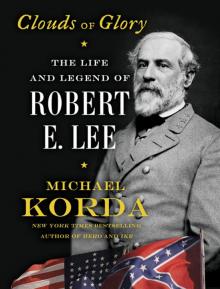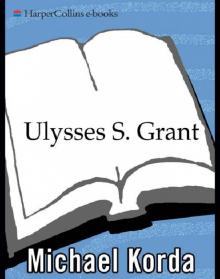- Home
- Michael Korda
Clouds of Glory Page 46
Clouds of Glory Read online
Page 46
Moreover, at this point in time Jackson and D. H. Hill would have to march at least five or six miles farther than they expected to reach Porter’s right flank, a task made more difficult by the fact that although everybody on the Confederate side referred to “Cold Harbor,” there were in fact two tiny hamlets—Old Cold Harbor and New Cold Harbor—separated by nearly a mile and a half and approached by different roads. Lee’s plan was that Jackson and D. H. Hill should turn the enemy’s right flank, and that A. P. Hill, supported by Longstreet as soon as he came up, should then attack Porter’s front and drive the enemy back “into the very mouth of Jackson’s artillery.”
It was 11 a.m. when Jackson remounted Little Sorrel after his talk with Lee. By noon, A. P. Hill’s skirmishers were exchanging fire with Union skirmishers in the marshy ground to the left of Porter’s position, which was far more formidable than Lee had supposed. It was not until after 1 p.m. that the sound of heavy firing from A. P. Hill’s division as it crossed Powhite Creek on the way past Gaines’s Mill toward New Cold Harbor drew Lee down Cold Harbor Road, where he instantly surmised that Porter’s line was drawn up not from north to south, but in a semicircle from the south and east. At that moment a number of men from Brigadier General Maxey Gregg’s South Carolinian Brigade began to retreat before it. “‘Gentlemen,’ Lee said to his staff and to the officers of [a nearby] battery, ‘we must rally those men.’ He spurred his horse into a gallop and soon was in the midst of the fleeing infantry, calling them to stop and for the honor of their state go back and meet the enemy.’” His appearance was sufficient to rally the troops, and Gregg soon appeared to lead his own men back into the woods. Over the next three years Lee would never hesitate to rally his troops and lead them forward toward the thick of the heaviest firing, serenely indifferent to danger. The troops of the Army of Northern Virginia soon realized that Lee would never ask them to do what he was not willing to do himself, and that he cared more for their lives than he did for his own.
As the day’s battle progressed thick woods, tangled undergrowth, and drifting gun smoke prevented Lee from getting a clear view of Porter’s position. There were two parallel roads—paths or farm tracks would describe them better—that led southeast to Despatch Station on the Richmond and York River railway line, and to the bridges over the Chickahominy River. Reasoning that Jackson’s advance would threaten Porter’s lines of retreat, and that Porter would then have to shift forces from his left and center to his right to forestall this, Lee decided on an immediate attack on the Union center by A. P. Hill, followed by an attack on the Union left by Longstreet’s division, to catch Porter at just the moment when he was moving his forces.
At 2:30 p.m. A. P. Hill attacked from “the Gaines’s Mill–Cold Harbor road,” advancing south, with his center at New Cold Harbor, in the direction of the road to the McGee house toward the woods which were less than half a mile away, his line extending just over a mile. What nobody seems to have accounted for was the existence of Boatswain’s Creek in front of them. It was screened from view by a low, thickly wooded ridge, which circled the higher ground in front of Hill like a boggy moat. Dense with greenery in the summer, in some places it was just a shallow, muddy trench or ditch, easily forded; in others it ran sluggishly between steep, slick banks that made it difficult to cross.
As Hill’s division approached Boatswain’s Creek over cleared farmland, a tangled line of brush and undergrowth concealed the low ridge in front of it until the last moment. When they crossed it they were momentarily silhouetted against the sky. The Federals opened fire with devastating effect.
Porter had placed his troops on the higher ground to the south and east of the creek. It was merely a broad, low, uneven series of hills and ridges, perhaps a mile in diameter, consisting of cleared farmland alternating with bands of thick woods, and sloping gently down toward the creek, but in warfare the importance of holding “higher ground” is absolute; it need not be a mountain, or steep sided—even a few feet of elevation is enough to give the defenders the advantage. Although Fitz John Porter was not popular with his fellow Union generals (he had a reputation for gossiping), he was a professional who knew his business. He had deployed his men and his artillery to give them as much protection as he could, placing them behind felled logs, knapsacks piled against post-and-rail fencing, and long lines of brush and timber, with a clear field of fire down the slope of the hill, which was so insignificant that it has no clear name, although the locals called the flat summit, about 150 feet high, facing west toward Powhite Creek, “Turkey Hill.”
The Confederate soldiers from A. P. Hill’s division who stumbled into the thick mud and swampy vegetation of Boatswain’s Creek were subjected to withering musket fire. For the Federal pickets and sharpshooters (as snipers were then called) it was like shooting fish in a barrel. Even if Hill’s men made it the other side, they were met with volleys of shrapnel from massed batteries less than 500 yards away. Regiment after regiment of his division struggled out of the creek bed and up the gentle slope and tried to form a line, but by 3 p.m. the entire hill was shrouded in thick, black smoke, and the sound of artillery fire was so strong that men who survived the Battle of Gaines’s Mill (as it came to be known) would remember it with particular horror to the very end of the war.
A Union war correspondent describes A. P. Hill’s attack from the other side as “a tornado of musketry,” driving the Union pickets back “into that dense wood where now corpses [were] as thick as the trees.” Despite repeated assaults the Confederate troops never got more than halfway up the sloping hill. In some places the Union troops confronting them were three lines deep—and the Confederates were “brutally repulsed.” Soon the survivors reappeared from the smoke, first in small numbers, then in whatever remained of whole units, the men retreating back to Cold Harbor Road, from where they had started. By 4 p.m. it was apparent to Lee that A. P. Hill’s attack had failed and that Porter was not weakening his left and his center to defend his right, as Lee had expected him to. Lee correctly concluded that Jackson was not yet in contact with the enemy.
Once again bad luck dogged Jackson. His wits may still have been dulled by exhaustion, and many historians have speculated that he may also have had an unconscious unwillingness to cooperate with Lee’s other major generals and give up what had been his largely independent role in the Valley. All of these things, or some combination of them, may well have been affecting Jackson, but his respect for Lee was only a little short of idolatrous.
It may be that nothing more was involved than yet another consequence of poor maps and general ignorance of the countryside around Richmond by the Confederate high command. To ensure that he arrived where Lee wanted him this time, Jackson had himself chosen a guide from among Stuart’s cavalry troopers who were native to the area, Private John Henry Timberlake. The Timberlake family’s farm “was midway between Ashland and Gaines’s Mill,” so there can have been no question that Timberlake knew his way, but Jackson himself may have been a victim of the confusion between “Cold Harbor Road,” “Old Cold Harbor” and “New Cold Harbor.” (New Cold Harbor was the place from which A. P. Hill had launched his unsuccessful attack against Porter’s center; Old Cold Harbor, from which Jackson was supposed to launch his attack on Porter’s right, was about a mile and a half farther north and east; and Cold Harbor Road was the most direct route linking them. Because of the rolling hills and the midsummer foliage, none of these places was instantly identifiable.)
11. Battlefield of Gaines’s Mill, June 27, 1862, with sketch of Jackson’s line of advance.
{Robert E. Lee, Volumes 1, 2, and 3, by Douglas Southall Freeman, copyright © 1934, 1935, by Charles Scribner’s Sons, copyright renewed 1962, 1963, by Inez Godden Freeman. All rights reserved.}
Jackson ordered the twenty-six-year old Private Timberlake to take him to Old Cold Harbor, and the two of them rode together silently—one of Jackson’s biographers, James L. Robertson Jr., comments that the general was “both very tired and
very ill humored,” and if this was true, it cannot have helped matters between them. They rode two miles from Walnut Grove Church to a fork in the road, then took the right fork, leading directly south toward Cold Harbor Road, which links, from west to east, Gaines’s Mill, New Cold Harbor, and Old Cold Harbor. They had not gone more than a mile and a half when Jackson heard the sound of a battle in front of him. “Where is that firing?” he asked Timberlake.
Timberlake replied that it seemed to be coming from Gaines’s Mill. Jackson was dismayed. “Does this road lead there?”
Private Timberlake began to explain that the road they were approaching went past Gaines’s Mill to Old Cold Harbor, but Jackson clearly feared that he was being led to the wrong place. He was determined not to repeat the mistake he had made the day before, and not to disappoint Lee again. “But I do not wish to go to Gaines’s Mill,” he said sharply, “I wish to go to Cold Harbor, leaving that place on my right.”
One can guess that Jackson made a forbidding figure, with his grim expression and the peak of his dusty old cap pulled low over his piercing eyes. When displeased, Jackson struck terror into soldiers of far higher rank than his young guide, and Timberlake can hardly have failed to realize that the major general riding beside him was furious. What Timberlake should have done was take a deep breath and explain that the road they were on would bring them out onto the Gaines’s Mill–New Cold Harbor–Old Cold Harbor road in less than half a mile, and that it was the fastest, most direct route to where Jackson wanted to go. Jackson may have made it clear, however, that he was in no mood to listen to explanations, and it is never easy for a mere private to argue with a major general.*
Timberlake was a young man of exceptional courage, and he seems to have felt insulted by Jackson’s tone, and perhaps by the fact that Jackson doubted his ability as a guide. At any rate he took refuge in what the British armed services call “dumb insolence,” and gave Jackson what sounds like a flip reply. “Then the left-hand road was the one which should have been taken,” Timberlake said, “and had you let me know what you desired, I could have directed you aright at first.”
This sounds as if Timberlake’s grammar has been tidied up for posterity, very likely by Major Dabney,* the theologian and preacher whom Jackson had put in charge of the army’s march from the Valley to the peninsula with such unfortunate results; but there is no mistaking the tone of a man who is washing his hands of the whole affair. If Jackson had continued to follow Timberlake’s route he would have reached Old Cold Harbor at the same time as D. H. Hill, making it possible for Jackson to attack the Union right while A. P. Hill’s men were still fighting—exactly what Lee had planned.
Though Private Timberlake could not have known it, one of Jackson’s few weaknesses as a general was his unwillingness to explain his orders, or to pay attention to other people’s opinion of them. Even so great an admirer as Major Dabney, who was within earshot at the time, remarks that the misunderstanding with Timberlake may have been caused because Jackson’s “habitual reticence, in this instance too stringent, withheld all explanation of his strategic designs.” A few words of explanation to young Timberlake might have saved a lot of time and lives, and hearing him out patiently even more.
At this point Jackson was riding at the head of a column of men that filled the road from Walnut Grove Church to the Gaines’s Mill pond. It was basically a narrow, rutted country lane with thick woods and tangled bush on either side. Thousands of men, not to speak of horses and horse-drawn artillery, had to turn around and march back in the direction from which they had laboriously come. This was not something that could be done quickly, or without confusion and long delays as the men tried to pass the word back down the column and sort themselves out.
Jackson not only had to back up and reverse his troops, but had to march them over four miles to reach Old Cold Harbor, and all this in brutal heat and suffocating dust, and to the noise of a major battle going on less than three miles away, in which they should have been taking part. Those who remember from their schooldays that the hypotenuse of a right triangle is shorter than the sum of the other two sides, and who look at the map, will instantly perceive the position in which Jackson had placed himself—he would now be marching away from the battle on the longest route to his place in it.
By retracing his route Jackson had also effectively vanished from sight. Lee sent several couriers to find him and tell him to attack at once, including his trusted staff officer Major Walter H. Taylor, but to no effect. Jackson had no option now but to continue the way he was going, however long it took him to get there. Dabny reports that “Jackson bore the same calm and assured countenance” as usual, and when someone suggested that “irreparable” harm might be caused by the delay, he replied, “No, let us trust that the providence of our God will so overrule it, that no mischief shall result.”
In the absence of Jackson, Lee was obliged to move on to a new plan. The Federals were not retreating; they were staying put—indeed there was some danger they might advance and overwhelm A. P. Hill’s “shattered division.” Consequently, Lee ordered Longstreet “to make a diversion” on the far right, until he had enough troops in position for “a general assault.” It was now about four o’clock in the afternoon, and Lee hoped to avoid another “draw,” like that of the day before, with the Federals remaining in possession of the field. Besides all the usual problems of the “fog of war,” estimates of the number of men on both sides were wildly mistaken. Porter had about 40,000 men on the field and assumed he was facing up to 75,000 Confederates. Lee had about 56,000 men, but so far more than half of them were not yet in action, and their whereabouts were uncertain. On the right, Longstreet decided that the “diversion” he was supposed to make would merely waste lives, and brought his troops forward to attack instead. In the center, where A. P. Hill’s exhausted troops had fallen back, the first elements of Jackson’s corps, under Richard Ewell and D. H. Hill, were gradually coming through the woods behind Telegraph Road and forming up on A. P. Hill’s left. There was no time to form a neat line of battle; Jackson’s straggling units simply took up positions as they reached them, under steady and increasing fire from the far side of Boatswain’s Creek. “D. H. Hill and Ewell were speedily engaged . . . and suffered heavily,” mostly from well-placed, effective Federal artillery, to which there was for the moment little or no reply, since Jackson’s guns were still behind him on the roads to Old Cold Harbor. General Richard Taylor, always hypercritical, notes, “Ignorance of the ground, densely wooded, and want of guides, occasioned confusion and delay.” Still, there is no question that having finally arrived where he wanted to go, Jackson took his time about deploying his men, and was at first still under the impression that he was to hold ground while A. P. Hill and Longstreet drove the Federals toward him. This tends to be taken as a criticism of Lee’s staff work, but it seems unlikely that Major Walter Taylor, who managed to find Jackson twice during the afternoon and urge him on, would not have shared Lee’s change of plan with him.
Just before six o’clock Lee, aware that the battle hung in the balance, rode out along Telegraph Road to meet Jackson, whom Freeman describes as “dust-covered, with his dingy cadet cap pulled down over his weak eyes, sitting awkwardly on an ugly horse, and sucking a lemon.” “Ah, General,” Lee said, “I am very glad to see you. I had hoped to see you before.”
Various interpretations of this greeting are given. James L. Robertson Jr., one of Jackson’s biographers, describes it as “warm,” whereas Freeman, Lee’s partisan, merely describes it as “tactful,” but with a nuance of reproach. Knowing what we do about Lee, it seems safe to assume that this was as close to criticism of a subordinate as he was likely to come. One senses behind Lee’s icy politeness a certain deft gift for irony. In any case, quite apart from Lee’s dislike of emotional scenes and confrontations, the last thing he would have wanted to do was dress Jackson down in front of his own troops, who were cheering wildly at the sight of the two men greeting each othe
r from horseback.
The sound of firing from the woods to the south had become “deafening,” and Lee wisely chose to ask a practical question. “That fire is very heavy,” he said. “Do you think your men can stand it?”
That seemed to arouse Jackson’s combative instincts. He glanced at the rising clouds of gun smoke and said gruffly, “They can stand almost anything. They can stand that.”
Lee’s presence seemed to wipe away Jackson’s fatigue. He quickly got his divisions into a semblance of order, and sent messengers from his staff to all his division commanders. “Tell them this affair must hang in suspense no longer! Sweep the field with the bayonet!” There was certainly no ambiguity about this order.
It was growing darker, shadows were lengthening, and the battle seemed to be hanging fire. After having left Jackson, Lee rode back down Telegraph Road toward New Cold Harbor, where he saw Brigadier General John B. Hood, at the head of the Texas Brigade—Hood had been his young companion back in the days when he had been searching for Indian tracks on the frontier in Texas. He quickly explained to Hood that the Union line must be broken in the center, whatever the cost. “This must be done,” he said urgently. “Can you break his line?” Hood stared at the woods on both sides of Boatswain’s Creek, and the high ground behind it, bristling with guns and bayonets and veiled in smoke. “I will try,” he said. “May God be with you,” Lee replied, and sent a messenger off to tell Longstreet on the far right to attack at once.

 Passing
Passing Another Life
Another Life Clouds of Glory
Clouds of Glory Hero: The Life and Legend of Lawrence of Arabia
Hero: The Life and Legend of Lawrence of Arabia Cat People
Cat People Hero
Hero With Wings Like Eagles: A History of the Battle of Britain
With Wings Like Eagles: A History of the Battle of Britain Ulysses S. Grant
Ulysses S. Grant